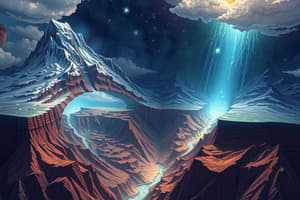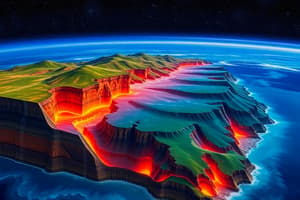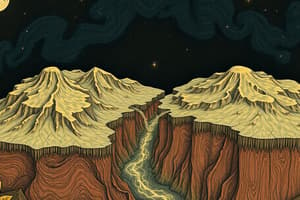Podcast
Questions and Answers
Subduction zones are regions where one tectonic plate moves under another plate.
Subduction zones are regions where one tectonic plate moves under another plate.
True (A)
Subduction zones typically result in the creation of shield volcanoes.
Subduction zones typically result in the creation of shield volcanoes.
False (B)
In subduction zones, the descending plate is often composed of lighter, less dense material.
In subduction zones, the descending plate is often composed of lighter, less dense material.
False (B)
The movement of plates in subduction zones can cause intense seismic activity.
The movement of plates in subduction zones can cause intense seismic activity.
Extinct volcanoes can often be found at subduction zones.
Extinct volcanoes can often be found at subduction zones.
Shallow earthquakes are most likely to occur at subduction zones due to their depth.
Shallow earthquakes are most likely to occur at subduction zones due to their depth.
Volcanic eruptions in subduction zones can lead to the formation of new landforms.
Volcanic eruptions in subduction zones can lead to the formation of new landforms.
The intensity of earthquakes tends to decrease with the depth of focus in subduction zones.
The intensity of earthquakes tends to decrease with the depth of focus in subduction zones.
Subduction zones are areas where tectonic plates collide and one plate moves under another.
Subduction zones are areas where tectonic plates collide and one plate moves under another.
In subduction zones, oceanic crust always rises above continental crust.
In subduction zones, oceanic crust always rises above continental crust.
Subduction zones can lead to the creation of mountain ranges and volcanic arcs.
Subduction zones can lead to the creation of mountain ranges and volcanic arcs.
The process of subduction occurs quickly and takes only a few years to develop.
The process of subduction occurs quickly and takes only a few years to develop.
Subduction zones are typically found at mid-ocean ridges.
Subduction zones are typically found at mid-ocean ridges.
The Pacific Plate is home to many subduction zones that lead to significant volcanic activity, such as the Ring of Fire.
The Pacific Plate is home to many subduction zones that lead to significant volcanic activity, such as the Ring of Fire.
Subduction zones do not affect the tectonic movements or the geological features of the Earth.
Subduction zones do not affect the tectonic movements or the geological features of the Earth.
Subduction leads to the recycling of the Earth's crust back into the mantle.
Subduction leads to the recycling of the Earth's crust back into the mantle.
Subduction occurs when a lighter oceanic plate collides with a denser continental plate.
Subduction occurs when a lighter oceanic plate collides with a denser continental plate.
Subduction zones can result in volcanic activity and the formation of ocean trenches.
Subduction zones can result in volcanic activity and the formation of ocean trenches.
The Pacific coast of South America is an example of a location where subduction occurs.
The Pacific coast of South America is an example of a location where subduction occurs.
During the process of subduction, the subducted plate is pushed into the lithosphere.
During the process of subduction, the subducted plate is pushed into the lithosphere.
Subduction zones are characterized by a lack of earthquake activity.
Subduction zones are characterized by a lack of earthquake activity.
Subduction can lead to the formation of an arc of islands.
Subduction can lead to the formation of an arc of islands.
The Asthenosphere is where subducted plates melt and contribute to volcanic activity.
The Asthenosphere is where subducted plates melt and contribute to volcanic activity.
The process of subduction results in the formation of mountain ranges through crimping of plate edges.
The process of subduction results in the formation of mountain ranges through crimping of plate edges.
Flashcards are hidden until you start studying




